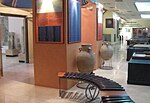Aleppo National Museum
 Entrance to the National Museum; Entrance of a late Hittite / Aramaic palace of Tell Halaf |
|
| Data | |
|---|---|
| place | Aleppo |
| Art |
Archaeological Museum
|
| opening | 1931 |
The Aleppo National Museum ( Arabic متحف حلب الوطني, DMG Matḥaf Ḥalab al-waṭanī ) is the largest museum in Aleppo and was founded in 1931. It is located in the center of the northern city, in Baron Street next to the Baron Hotel and near the bell tower of Bab al-Faraj . The main focus of the museum's exhibition is on archeology of Syria , with most of the finds coming from the northern part of the country.
history
After a decision by the Syrian authorities, a small Ottoman palace was converted into a national museum in 1931 . After the building had been in use as such for around three decades, it was demolished in 1966 and replaced by a larger and more modern structure in order to meet the growing need for space with the number of exhibits.
In the course of the civil war in Syria , more than 24,000 objects were brought to Damascus for security in 2015 .
Collections
Objects from all historical periods are exhibited in the museum. However, the focus is on the Iron Age and the Islamic Period. Most famous is the entrance to the museum, a reconstruction of the monumental facade of a late Hittite / Aramaic palace from the 9th century BC. From Tell Halaf .
ground floor
The ground floor houses two departments: the Department of Prehistoric Culture and the Department of Ancient Syrian Civilizations.
The first section is housed in a large hall in which there are various Stone Age tools and objects from Aleppo, Ain Dara and Ebla . This also includes the reconstruction of one of the oldest man-made huts (approx. 8,500 BC) from Mureybet .
The second section comprises several rooms that are geographically grouped according to Syria's regions. There are numerous objects from the Bronze Age from Hama and Ugarit , statues and inscribed clay tablets by Mari and artifacts found by Max Mallowan in Tell Brak . There are also Iron Age objects and statues in Assyrian style from excavations in the Jazira and along the Euphrates .

The main rooms on this floor are:
- Room of the hill of the Jazira.
- Mari room with the goddess bubbling water
- Hama region space.
- Ugarit room.
- Tell Halaf room.
- Arslan Tash room.
- Tell Ahmar room.
- Room of ancient statues and cuneiform tablets.
- Ebla room.
First floor
The upper floor of the museum comprises three sections:
- Classical Artifacts Department: Various objects from the Greek, Hellenistic, Roman and Byzantine periods such as coins, glass mosaics and ceramics.
- Department of Arabic-Islamic History: Various Arabic coins, manuscripts, ceramics, and a sarcophagus and astrolabe, each from the 12th century AD.
- Modern Art Department: works by modern artists from Aleppo and Syria; but also a true-to-scale model of the old town of Aleppo and a mosaic from the sixth century AD.
Yards
The inner courtyard houses monumental basalt statues of ancient mythical figures from the Hittites and Romans as well as a large mosaic from the third century AD. In the forecourt, however, monuments of Assyrian, Aramaic, Byzantine and Arab origin are on display.
- Aleppo National Museum
literature
- Soubhi Saouaf: Le musée d'Alep , Aleppo 1962
Web links
Individual evidence
- ^ Rolf Brockschmidt: Aleppo's old town after the fighting: “Politics changes, the cultural heritage remains”. In: tagesspiegel.de. February 13, 2017, accessed February 6, 2018 .
- ^ Aleppo Museum. In: syriagate.com. Archived from the original on May 26, 2009 ; accessed on October 25, 2018 (English).
- ↑ Aleppo.us: Aleppo Museum ( Arabic ) Aleppo.us. Retrieved August 12, 2009.
Coordinates: 36 ° 12 ′ 18 ″ N , 37 ° 9 ′ 0 ″ E



